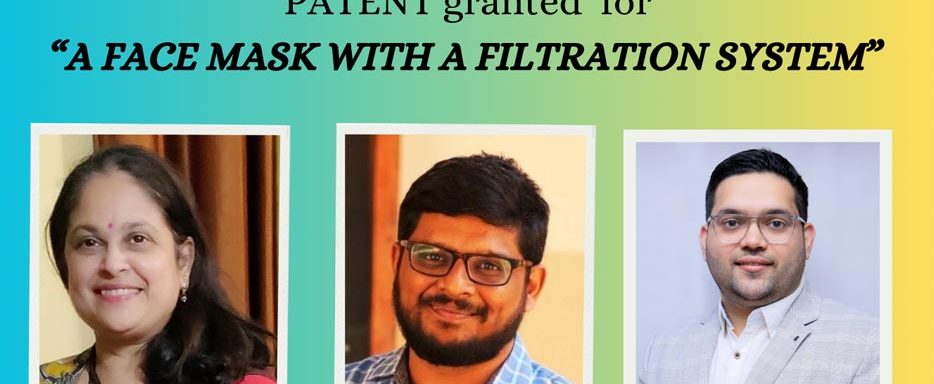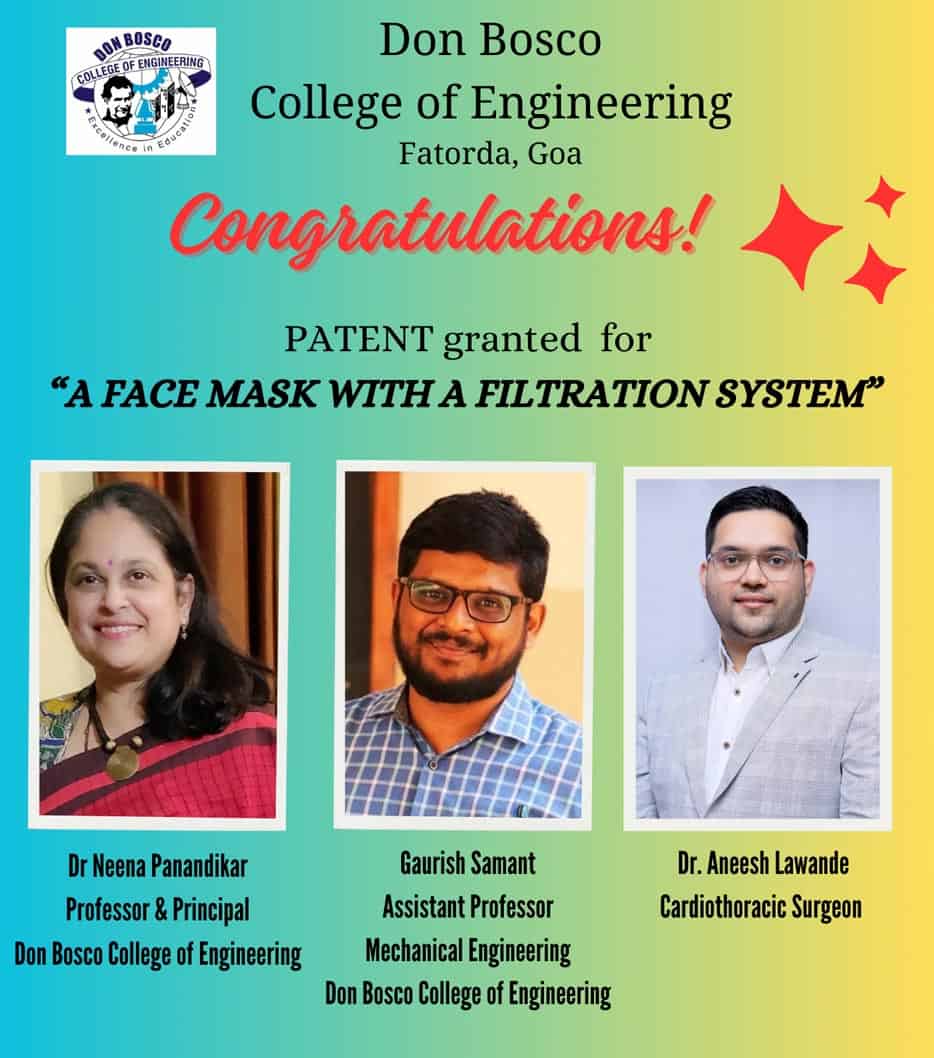(Don Bosco College Of Engineering, Fatorda) – Professor and Principal, Don Bosco College of Engineering (DBCE) Dr Neena Panandikar, Assistant Professor, Mechanical Engineering, DBCE, Gaurish Samant, and Cardiothoracic Surgeon, Dr Aneesh Lawande, were granted patent by the Indian Patent Agency for, A Face Mask with a Filtration System, developed during the COVID-19 pandemic.
This patent underscores their innovative contributions to public health and safety in India and globally. Amidst the COVID-19 pandemic, the demand for effective personal protective equipment (PPE) soared, particularly for face masks. Conventional masks offered limited protection against airborne viruses, highlighting the need for a high filtration mask capable of filtering out a broader range of particles to mitigate the spread of the virus.
The granting of the patent by the Indian Patent Agency acknowledges the groundbreaking contributions in the field of personal protective equipment. The development of a high filtration face mask holds immense potential in reducing the transmission of infectious diseases, including COVID-19, and safeguarding public health in India and beyond.
Converage by the Navhind Times
Diana Fernandes
Margao: The Idea for invention emerged during the early days of Covid-19; application was made in Nov 2020An innovative face mask with a filtration system developed as a joint effort by a Goan team of a doctor and engineers was recently awarded a certificate of patent by the central government’s Patent Office.
Though the patent took four years, the team that developed and received the rights say the process is becoming simpler now.
The team comprised Don Bosco College of Engineering (DBCE), Fatorda, principal Dr Neena Panandikar, Assistant Professor of Mechanical Engineering Gaurish Mahabaleshwar Samant and cardiothoracic surgeon Dr Aneesh Deepak Lawande.
They had applied as the patentees in November 2020 and received the patent certificate last week.
It is pertinent to note that a cost-effective composite brick made of laterite and developed as a final year project by students of the Fatorda college received patent certificate from the agency of the central government earlier this year.
The idea for the face mask with filtration was developed during the coronavirus pandemic when it was relatively new. “We had come together to develop this face mask during the first wave of Covid when face masks were not available. We developed this face mask with the help of Dr Lawande, who was working with PPE kits and had an understanding of the medical side of things. We worked on it for about three to three and a half months after which we applied for the patent,” says Samant.
What they developed was a face mask whose main frame was made with a 3D printing platform; it has a unique filtration system that can be replaced. The filtration system was developed from non-woven indigenous material available in India instead of relying on the one manufactured in China.
The filter comprises PM 2.5 filter and absorption layers, which are low in cost and easily replaceable.
“During the Covid-19 pandemic, I recognised the urgent need for an effective, high-filtration mask that prioritised both functionality and comfort. Determined to turning this idea into a reality, I reached out to Gaurish Samant, confident that his proactive and innovative mindset could lead to a solution with a positive impact on public health. Turning an idea into a dream requires delving into the depths of one’s imagination to visualise and conceptualise an in a more abstract and creative manner,” says Dr Panandikar.
She thanked Assistant Professor Samant for applying his exceptional engineering skills and creative thinking to bring this incredible achievement to fruition.
“I would also like to express my sincere thanks to cardiothoracic surgeon Dr Aneesh Lawande for his valuable contribution to this endeavour. Together we have been able to develop a remarkable solution,” Dr Panandikar says.
But even though the patent took four years in the making, the situation and times are changing.
“Though it took us four years, the awareness in India is growing. In the last three to four years, there has been a gradual increase in the number of patents being applied for in India. In countries like Australia patents are sometimes awarded within the short period of six months. In India too it won’t be long before the time period reduces,” Samant hopes.
The interest in applying for patents has been growing in the past several years in the state as well. The mainstay behind applying for a patent is of ownership. The patentee is given ownership of the innovation or idea which competitors won’t be able to steal or copy. Once received, the patentee can also engage in transfer of technology with firms and companies willing to manufacture the item for a royalty.
Source: Salesians of Don Bosco, Province of Panjim, Goa ; Navhind Papers & Publications


